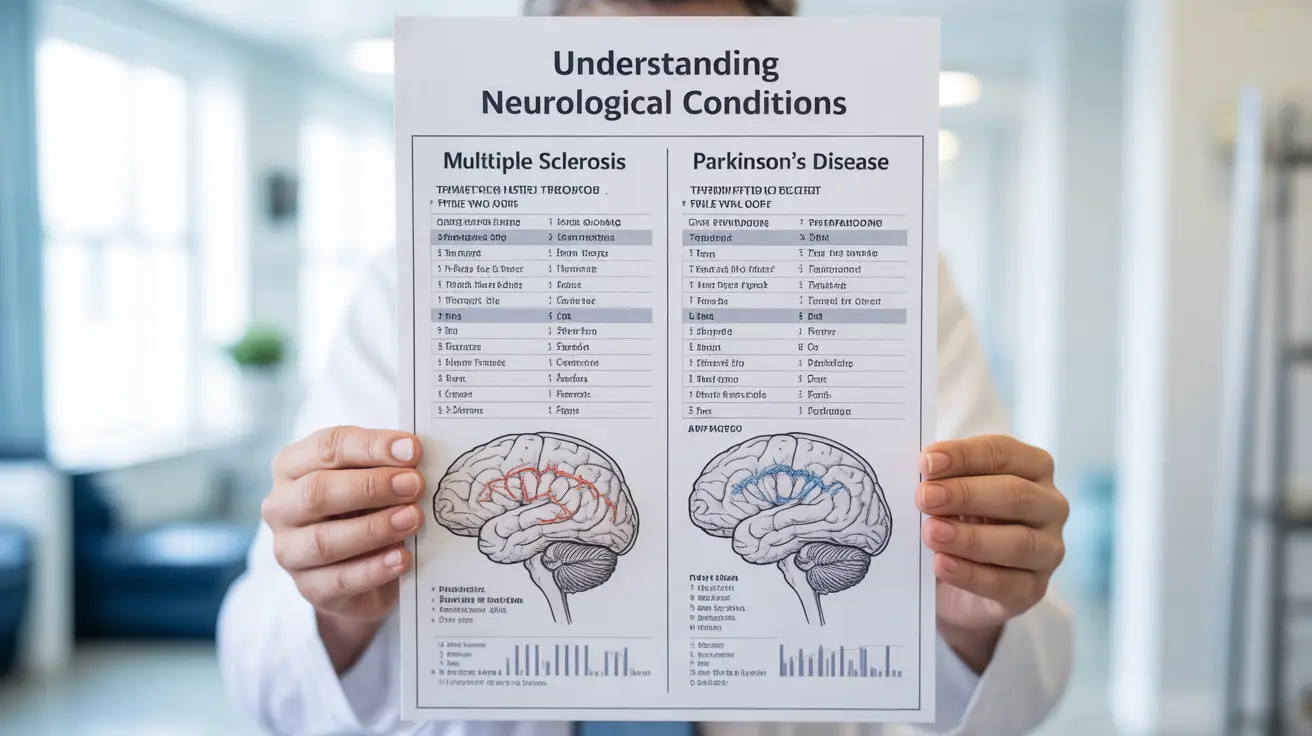Multiple sclerosis (MS) and Parkinson's disease are both neurological conditions that can significantly impact a person's quality of life, but they have distinct characteristics, symptoms, and treatment approaches. Understanding these differences is crucial for proper diagnosis and management of both conditions.
While both diseases affect the nervous system, they do so in fundamentally different ways. MS is an autoimmune condition affecting the protective covering of nerve fibers, while Parkinson's disease primarily impacts dopamine-producing cells in the brain. Let's explore these important distinctions in detail.
Key Differences in Symptoms
The symptoms of MS and Parkinson's disease can sometimes appear similar, but there are crucial distinctions that help differentiate between the two conditions:
Multiple Sclerosis Symptoms
- Vision problems, including double vision and vision loss
- Fatigue and weakness that can come and go
- Numbness and tingling sensations
- Balance issues and coordination problems
- Cognitive challenges, including memory issues
- Heat sensitivity
- Bladder and bowel problems
Parkinson's Disease Symptoms
- Tremors, particularly when at rest
- Slow, rigid movements (bradykinesia)
- Poor balance and postural instability
- Shuffling gait
- Changes in handwriting (micrographia)
- Reduced facial expressions
- Speech changes
Disease Progression and Age of Onset
The way these diseases develop and when they typically appear can help distinguish between them. MS usually begins between ages 20 and 40, affecting women more frequently than men. Parkinson's disease typically develops after age 60, though early-onset cases can occur.
Diagnostic Approaches
Doctors use different diagnostic tools and methods to identify each condition:
MS Diagnosis
- MRI scans showing lesions in the brain and spinal cord
- Lumbar puncture to analyze cerebrospinal fluid
- Visual evoked potential tests
- Blood tests to rule out other conditions
Parkinson's Diagnosis
- Clinical examination of movement and symptoms
- DaTscan imaging to visualize dopamine systems
- Response to levodopa medication
- Detailed medical history and neurological examination
Treatment Strategies
Treatment approaches vary significantly between these conditions, reflecting their different underlying causes:
MS Treatment Options
- Disease-modifying therapies to reduce relapses
- Corticosteroids for acute flare-ups
- Symptom-specific medications
- Physical therapy and rehabilitation
- Lifestyle modifications
Parkinson's Treatment Options
- Dopamine replacement therapy (levodopa)
- Dopamine agonists
- MAO-B inhibitors
- Deep brain stimulation in advanced cases
- Physical therapy and exercise programs
Frequently Asked Questions
What are the main differences in symptoms between multiple sclerosis (MS) and Parkinson's disease?
The main differences lie in symptom presentation. MS typically causes vision problems, fatigue, and recurring neurological symptoms that come and go. Parkinson's disease primarily causes movement-related symptoms like tremors, slow movement, and rigid muscles, which tend to be more consistent and progressive.
How do doctors diagnose MS versus Parkinson's disease?
MS is typically diagnosed using MRI scans, spinal fluid analysis, and various neurological tests. Parkinson's disease is mainly diagnosed through clinical observation of symptoms, DaTscan imaging, and response to medication trials.
At what age do MS and Parkinson's disease typically start, and does this help tell them apart?
Yes, age of onset is a helpful distinguishing factor. MS typically develops between ages 20-40, while Parkinson's disease usually occurs after age 60. However, both conditions can occasionally develop outside these typical age ranges.
Can someone have both multiple sclerosis and Parkinson's disease at the same time?
While it's extremely rare, it is technically possible to have both conditions simultaneously. However, this occurrence is so uncommon that when symptoms of both appear, doctors typically look for other explanations first.
What treatment options are available for managing symptoms of MS compared to Parkinson's disease?
MS treatments focus on immune system modification and managing specific symptoms, using medications like disease-modifying therapies and corticosteroids. Parkinson's disease treatments primarily aim to increase dopamine levels through medications like levodopa and may include surgical options like deep brain stimulation.




